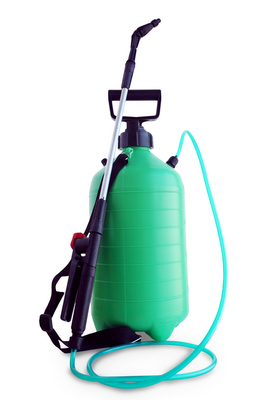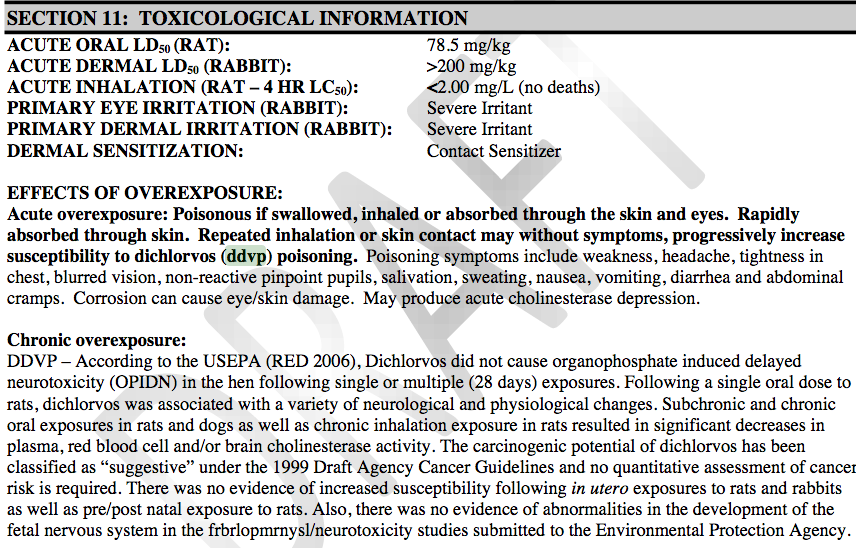The Zika Virus
We are not here to tell you what the Zika Virus is, you already know that. You also probably know there are two sides to every story, and I am not going to try to convince you of that. What I am saying is what we have researched about the actual ingredients in the spray, and how that concerns your health.

In 92% of all incidents used, regardless what spray it was called, or used for, was made with
Dichlorvos (DDVP) which was developed from nerve gas agents after the end
of World War II in 1955.
Dichlorvos, like other organophosphates,
work on the nervous systems of insects, and humans.
Evidence has been presented it is claimed to damage DNA of insects. Don't you think it is doing the same to humans?
DDVP exposure can happen anywhere. You can breathe it in, absorb it into the skin, swallow it, or have eye contact. However the means, you have toxins working in your nervous system. Long term exposure you be deadly.
Symptoms of dichlorvos exposure may include weakness, headache, tightness in chest, blurred vision, salivation, sweating, nausea, vomiting, diarrhea, abdominal cramps, eye and skin irritation, miosis (pupil constriction), eye pain, runny nose, wheezing, laryngospasm, cyanosis, anorexia, muscle fasciculation, paralysis, dizziness, ataxia, convulsions, hypotension (low blood pressure), and cardiac arrhythmias.
These screenshots are from the actual Material Safety Data Sheet on Chemical compounds and the Zika Virus. I have highlighted the occurrences of DDVP on the entire document for you.

Poisonous if swallowed or absorbed through skin? So food is out, breathing is out, so now what? Oh by the way, don't go to the toilet without washing your hands first. One of the labels warnings actually insist you wear a protective suit before use.


Center For Disease Control (CDC)
Zika Virus Claims
The Centers For Disease Control says:
Naled (the term they give DDVP when it begins to break down on surfaces) is not a problem. In small quantities DDVP has not been shown to cause health problems in people. DDVP does not build up in breast milk or breast tissue. When aerial spraying is done correctly, it does not cause asthma attacks.
If you look at the wording on their huge page, you will see the pattern of every precaution begins with small quantities. It feels, looks, and reads like they are hiding something maybe? Doesn't that tell you something about repeated exposures? You can read the entire Zika Virus explanation from the CDC here.
Zika Virus Claims Outside US
Looking outside the United States mainstream media and Medical associations, I find an entirely different story where it says, "Dichlorvos (DDVP) - a hazardous organophosphate"
- Health issues-Acute toxicology-Dichlorvos has a high acute toxicity: the oral LD50 in rats is between 56 and 108mg/kg. It is classified by the WHO as a Class IB, 'highly hazardous'. The dermal toxicity is similar to oral toxicity, and dermal exposure is a cause for concern.
- Chronic toxicity-Reproductive effects-The HSE review found: "No fertility studies which are both adequately conducted and reported... Individually no study is considered adequate to assess the teratogenic potential of dichlorvos in any species".
- Neurotoxicity-There is evidence that dichlorvos can induce delayed neuropathy in hens at very high doses; and neurophysiological and behavioural changes in rats. But the HSE decided: "The significance of these findings for the risk assessment of dichlorvos is uncertain.
- "Carcinogenicity-The International Agency for Research on Cancer places dichlorvos in Group 2B (possibly carcinogenic to humans) based on what it considers to be sufficient evidence in animals, but inadequate evidence in humans. The US Environmental Protection Agency classifies it in category 2B (possibly carcinogenic to humans) but the result of further testing is awaited and it may be reclassified.
- Genotoxicity-There is evidence that dichlorvos is mutagenic in bacteria, fungi, and mammalian cells in vitro, but that there is no evidence for mutagenicity in whole animals, when it is rapidly degraded.
- Environmental effects-Dichlorvos is toxic to fish and aquatic arthropods are more sensitive than fish. It is highly toxic to birds and to honey bees.
- Environmental Quality Standards have been proposed for the protection of UK freshwater and marine aquatic life. In setting the standards for dichlorvos, the Department of the Environment noted that "insufficient environmental data are available to verify the proposed standards for the protection of aquatic life."(9) However, by applying an arbitrary safety factor of 100 to the toxic dose for the most sensitive species, the Water Research Centre has recommended an annual average level of 0.001 µg/l (parts per billion) for freshwater species, and 0.04 µg/l for marine life in saline waters.
As a result of the Second North Sea Conference in 1987, a number of countries agreed to reduce discharges of certain chemicals to water. Dichlorvos is included in the UK Red List substances whose discharge is dangerous to water.
Concerns for Salmon farming-There was an increase in the incidence of cataracts and blindness in wild salmon in the 1980s and this has been linked with exposure to dichlorvos.
Dichlorvos has caused poisonings in China, Costa Rica, Paraguay, India, Papua New Guinea and Egypt. It is also widely produced - there are facilities in India, Brazil and Mexico. One manufacturer, Ciba Geigy, has agreed to withdraw dichlorvos from sale in the Colombian flower industry.
Conclusions
It is accepted that dichlorvos is dangerous to a number of aquatic species and that the discharge of dichlorvos to water should be reduced. Dichlorvos can inhibit cholinesterase levels in humans which may lead to short or longer term neurotoxic effects.
FIRST AID MEASURES - Zika Virus Ingredient DDVP
IF SWALLOWED:
Call a poison control center or doctor immediately for treatment advice. Do not give any liquid to this person. Do not give anything by mouth to an unconscious person. Do not induce vomiting unless told to by a poison control center or doctor.
IF INHALED:
Move person to fresh air. If person is not breathing, call 911 or an ambulance, then give artificial respiration, preferably mouth-to-mouth if possible. Call a poison control center or doctor for further treatment advice.
IF IN EYES:
Hold eye open and rinse slowly and gently with water for 15-20 minutes. Remove contact lenses, if present, after the first 5 minutes, then continue rinsing eye. Call a poison control center or doctor for treatment advice.
IF ON SKIN OR CLOTHING:
Take off contaminated clothing. Rinse skin immediately with plenty of water for 15-20 minutes. Call a poison control center or doctor for treatment advice.
There are other way to control mosquitoes and contracting the Zika Virus.
When Mosquitoes bit an infected person they can then infect the next 5 people in the same “blood meal”. The answer is...ward them off, using repellants...safe ones.
A natural way to ward off mosquitoes is to consume more Vitamin B1. You can begin here with the high B1 recipe.
Leave the Zika Virus to learn more about Health and Safety.
Go to the Homepage of Health-Current Events
Click any Social Media link to share this page forward. Feel free to Pinterest us too!